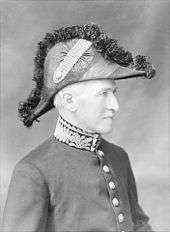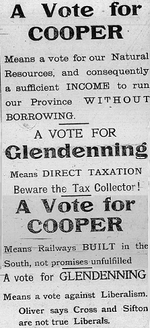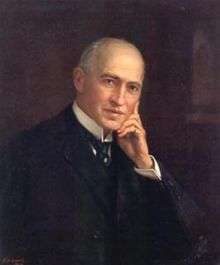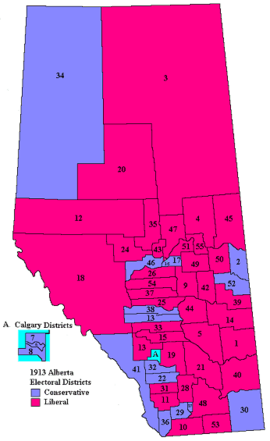Alberta general election, 1913
| | |||||||||||||||||||||||||||||||||||||||||||||||||||||||||||||||
| |||||||||||||||||||||||||||||||||||||||||||||||||||||||||||||||
| |||||||||||||||||||||||||||||||||||||||||||||||||||||||||||||||
|
| |||||||||||||||||||||||||||||||||||||||||||||||||||||||||||||||
| Map of 1913 Provincial electoral districts | |||||||||||||||||||||||||||||||||||||||||||||||||||||||||||||||
| |||||||||||||||||||||||||||||||||||||||||||||||||||||||||||||||
The Alberta general election of 1913 was the third general election for the Province of Alberta, Canada. The writ was dropped on 25 March 1913 and election day was held 17 April 1913 to elect members of the Legislative Assembly of Alberta. Elections in two northern districts took place on 30 July 1913 to compensate for the remote location of the riding. The method to elect members was under the First Past the Post voting system with the exception of the Edmonton district which returned two members under a plurality block vote. The writ period for the general election was very short being 23 days.
Premier Arthur Sifton led the Alberta Liberal Party into his first election as leader, after taking over from Alexander Rutherford. Premier Rutherford had resigned for his government's involvement in the Alberta and Great Waterways Railway Scandal but remained a sitting member. Sifton faced great criticism for calling the snap election, after ramming gerrymandered electoral boundaries through the legislature, running up the provincial debt and neglecting on promised railways. Labor candidates in this election allied with the Liberal government and not run under a labor banner.
Edward Michener, the official opposition leader of the Conservative Party, ended up capitalizing on anger toward the Sifton government. He would lead the largest opposition to date in Alberta history. The Liberals would win a comfortable majority of seats despite being almost even in the popular vote. The Socialist Party vote would collapse and lose their only seat as Charles M. O'Brien went down to defeat at the hands of a Conservative.
Events leading to the election
The campaign

The writ of election was issued after a sitting of the house on the night of 25 March 1913. The premier dropped the election writ and dissolved the house after he ensured that the governments legislation on new electoral boundaries had been given Royal Assent. The new boundaries gave the Liberals an advantage, not only were they blatantly gerrymandered to their favour, but the opposition and even private citizens had a tough time figuring out what district they were in.

Day one of the campaign brought controversy as it was reported that Hotel organizers and Liquor establishments were being expected to donate generously to the Liberal campaign in order to get licence renewals for their establishments.
Arthur Sifton and his lieutenant Charles Cross both contested nominations in two electoral districts. It was reported in the Calgary Herald that were so scared of the electorate they felt they might not win if they faced just one district. The media accused Premier Sifton of having little confidence in his ability to return his government to power. The Liberal party in order to prevent possible vote splitting made deals with local trade unions and labour organizations to prevent candidates from running under the Labour banner.
The Conservative Party would protest the snap election by filing a legal injunction in the Supreme Court, to prevent the election from being held on 17 April 1913. The grounds for the injunction were based on the date of nomination closure being in violation of statue. The writs were issued with nomination day being 10 April 1913. The Conservatives argued that this was 10 hours short of the 16 full days prescribed in the Elections Ordinance, and the election should be ruled invalid.
Election issues

The big issues of the election centred on the Sifton government's lack of infrastructure building in Southern Alberta.
The ballooning Alberta debt which in a few years had gone from C$2 million to C$27 million was talked about often.
Gerrymandered boundaries
Prior to the dropping of the writ the Sifton government forced a bill through the Legislative Assembly of Alberta. The bill was entitled Bill 90: An Act to Amend an Act concerning members elected to the Legislative assembly of Alberta It was introduced in the assembly on 20 March 1913 and given Royal Assent on 25 March 1913.
The bill increased the amount of electoral districts in the province by 25. The boundaries did not contain equal population with one riding Clearwater only containing 74 people enumerated. Calgary Centre was the largest population wise with 20,000 people enumerated. The bill drawn with a line at the centre of the province gave 30 seats to the north half of the province with 26 seats in the south.
The Conservative and Socialist opposition vigorously opposed the bill, but failed to pass any amendments. The bill was jammed through third reading in the 25 March legislative sitting and given Royal Assent that evening, just shy of the writ of elections being dropped.
Siftonism

The Liberal campaign was dubbed "Siftonism" inferring that Sifton was a disease that needed to be cleaned from Alberta. The media at the time picked up on that, and roasted the Liberal party. The Conservative party attacked the Liberals on the Railway Scandal and Lack of provincial infrastructure.
Results
The final result was the Liberal Party, under its new leader, Arthur L. Sifton, won a third term in office, defeating the Conservative Party, which was once again led by Edward Michener.
The opposition received a much higher proportion of the votes and increased its seat count to 17 from 2, while the Liberals again got more votes than the Conservatives and won many of the new seats, allowing them to hang on to a majority.
The votes were split almost evenly between the Conservatives and Liberals with a difference of 4 percent separating the two parties. In the Rocky Mountain constituency, the Socialist vote doubled but the vote for the Conservative went up even more, to make that candidate the winner, and the Socialists lost their only seat in the Assembly.
Oddly, the Assembly did not have its full complement of MLAs after the election, as C.W. Cross was elected to two seats. When this happened elsewhere, such as Laurier's election as MP in both the North-West Territories (including part of what would be Alberta) and Quebec, the double winner resigned one of the seats. But Cross held both seats until the next general election.
Summary
| Party | Party Leader | # of candidates |
Seats | Popular Vote | |||||
|---|---|---|---|---|---|---|---|---|---|
| 1909 | Elected | % Change | # | % | % Change | ||||
| Liberal | Arthur L. Sifton | 51/541 2 | 36 | 38/391 | +8.3% | 47,748 | 49.23% | -10.03% | |
| Conservative | Edward Michener | 56 | 2 | 17 | +750% | 43,737 | 45.10% | +13.4% | |
| Independent | 14 | 1 | - | -100% | 3,639 | 3.75% | +0.36% | ||
| Socialist | Charles M. O'Brien | 5 | 1 | - | -100% | 1,814 | 1.87% | -0.73% | |
| Liberal-Labor | Arthur L. Sifton | 23 | * | - | * | 4 | 4 | * | |
| Independent Liberal | 1 | 1 | - | -100% | 47 | 0.05% | -2.57% | ||
| Total | 129/132 | 41 | 55/56 | +36.6% | 96,985 | 100% | |||
| Source: Elections Alberta | |||||||||
Note
- Charles Cross ran in and won in two ridings.
- Arthur Sifton and Alexander G. MacKay ran for the Liberals in two districts but only won in 1 district.
- Liberal-Labor candidates were a result of the Liberal Labour coalition struck by Premier Sifton prior to the election, these candidates ran in place of Liberals. See also Liberal-Labour (Canada).
- Liberal-Labor popular vote is included in Liberal vote.
| Party name | Calgary | Edmonton1 | North | Central | South | Total | |||
|---|---|---|---|---|---|---|---|---|---|
| Liberal | Seats: | 0 | 1 | 11 | 15 | 11 | 38 | ||
| Popular vote: | 32.1% | 40.3% | 37.9% | 32.5% | 19.8% | ||||
| Conservative | Seats: | 3 | 2 | 1 | 5 | 7 | 18 | ||
| Popular vote: | 50.5% | 31.5% | 38.3% | 44.1% | 55.5% | ||||
| Total seats: | 3 | 3 | 12 | 20 | 18 | 56 | |||
| Parties that won no seats: | |||||||||
| Socialist | Popular vote: | 5.5% | 1.0% | 3.1% | 1.2% | 2.8% | |||
| Independent | Popular vote: | 0.1% | 0.2% | - | - | 0.1% | |||
| Independent Liberal | Popular vote: | 0.1% | 0.2% | - | - | 0.1% | |||
Members of the Legislative Assembly elected
For complete electoral history, see individual districts
Charles Cross was elected in both Edson and Edmonton and represented both ridings until 1917
30 July 1913
| District | Member | Party | |
|---|---|---|---|
| 3 | Athabasca | Alexander Grant MacKay | Liberal |
| 34 | Peace River | Alphaeus Patterson | Conservative |


